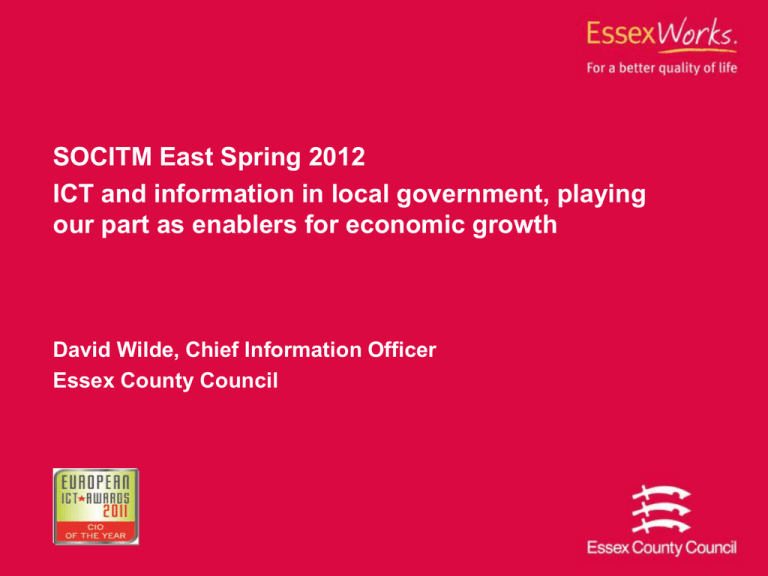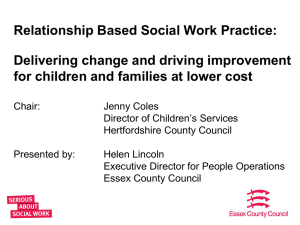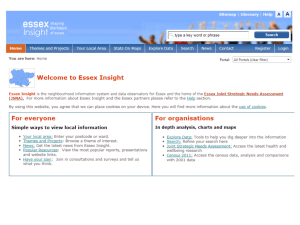ICT and information in local government
advertisement

SOCITM East Spring 2012 ICT and information in local government, playing our part as enablers for economic growth David Wilde, Chief Information Officer Essex County Council Essex: delivering the best quality of life Essex County • • • • • • 1.4 million residents 368,000 hectares 596,500 homes 60,000 businesses 4,642 miles of road £20 billion local economy Essex County Council: • £2.13 billion gross budget – but shrinking rapidly • 48,000 employees (34,000 in schools) • 210,000 pupils across 571 state and 52 private schools • Partners include 5 PCTs, 12 district and borough councils, two unitary authorities, 270 parish councils 2 The Essex economy – some key issues Productivity • GVA in Essex is £16.4k per head, compared with £18.5k in the Eastern Region and £20.5k in England (2009) • Most growth in Essex (business units) over the period 1999 – 2008 was in construction, financial services and the public sector; most contraction was in manufacturing Employment • Across Essex 73.1% of the working age population are employed, compared to the national average of 70.4%. • Unemployment doubled since 2008. Hotspots in Basildon, Tendring and Harlow • NEET figures as % of 16-19 cohort largely stable 2009-11 - Essex NEET figures are higher than statistical neighbours and than East of England average • Largest employment sectors are: Health; Education; Retail; Manufacturing and Business Support • Largest fall in employment 2009-11 has been in the construction industry 3 The Essex economy – some key issues Enterprise • Births of new enterprises has slowed down – from c6,900 new enterprises created in 2007 to 5,900 created in 2010 • Enterprise failures have increased – c5,900 ended in 2008; nearly 7,000 died in 2009 and 2010 • Total number of enterprises fallen from around 59,000 to below 58,000 Education • Behind national average at GCSE, Early Years and Adult Skills levels 2, 3 and 4 • Boys falling behind girls • A less skilled workforce - higher skills levels lower than national average Earnings • Resident population earnings higher in 2011 than 2009; working population earnings slightly lower in 2011 than 2009 (but did recover 2010-11) • Working population average earnings (c£21k pa) lower than resident population average earnings (c£24k pa) 4 Essex Integrated County Strategy Employability & skills Enterprise & innovation Places Infrastructure & utilities 5 Objectives • To help Essex businesses to be more productive, innovate and grow and create jobs for local people by securing the infrastructure and environment that they need to attract investment and unlock sustainable growth opportunities. • To help Essex businesses to compete and trade internationally, thereby expanding the county’s international connections and market opportunities. • To help individuals to prepare for and access work opportunities and better paid jobs through an education and skills offer that meets the needs of businesses. • To improve the life chances of people in our most deprived areas by recognising and investing in social capital. • To support and create vibrant communities, helping to ensure that citizens can access jobs and public services in an efficient and sustainable way. IS Strategy for Essex County Council End User Computing Includes data, voice, video & conferencing Reduced cost per user per annum for device, file storage, security, connectivity & support Information Governance Supports Freedom of Information Act, Data Protection Act, Regulation of Investigatory Powers Act & compliance e.g. Munro Review of Child Protection Collaboration Social Networking, SharePoint, Collaboration, Etc. IT Skills & Capacity Professionalism, Capacity & Capability Customer Centric Services Business Applications, Cloud Services, Business Intelligence, Application Programming Interfaces Convergence via the Next Generation Network and PSN Information BI and GIS are the growth areas for public sector ICT over the next few years: • Politicians need much more detailed, dynamic information to make harder decisions about deploying fewer resources • Organisations need to be able to better manage diminishing resources around workforce, property and delivery • The public are already becoming very demanding about knowing where the money is going • Our information is still spread all over the place So, politicians, business and the public all want it and we can deliver it as a key enabler for helping to better manage resources and change Unemployment and the impact on health and well being 9 ICT Delivery ICT Shared service initiatives have been focussed on organisations, not services. This is changing: • Other shared services are already quite mature in HR and a number of front line operations • ICT as a service now growing in library services, elements of core social care and BI • There is a renewed interest in education ICT support and schools broadband is holding up well • Converged networks looking really good and is unlocking wider opportunities on shared accommodation and mobility So, a different slant on ICT as a shared service and a real opportunity to grow beyond local government into new markets. We can help with skills growth too Economic Growth This is where corporate ICT can really start to add value to our localities: • Converged networks combined with infrastructure investment offers huge potential now and for the future, with communications infrastructure playing into local planning frameworks • Our combined buying power and reach based on location will help us unlock hard to reach areas. We don’t just operate in the BDUK silo • Job creation and skills development, the Council ICT function and apprenticeships, partnering and buying from local tech SMEs • Inward investment opportunities by bringing our knowledge to the EDO table So, we should be in there with the FE and HE community to help on skills and looking beyond our internal customer base to exploit our assets Digital divide and the Voluntary Sector We can use our assets and commercial links to support both: • Community computer schemes, re-using spent ICT end user devices for charities to reach the digitally excluded, working with not for profits and large ICT commercial outfits through social capital • Unlocking our infrastructure and estates (physical and technology) for controlled use by third sector. PSN based converged networks should enable that provided we don’t all start wiring in IL3 infrastructure! • Our knowledge and skills to help the voluntary sector? • Collaboration environments to help community groups and low cost/no cost wifi Local government is a long standing supporter of voluntary sector through grants. As they reduce we can replace some of that with services in kind. ICT at the heart of community and economic growth • Excellent public access to services beyond just web, libraries of the future as gateways to facilitated service provision? Hubs? Collaboration space? • Improving basic access – training, equipment, bandwidth, location • Partners – voluntary sector play a major role in all this, technology must enable joint working – collaborative solutions with communities • Transparency – data stores available to all and information governance that spans all service delivery partners and information owners (citizens) • People able to operate across organisations through role based access control in a virtual end user computing world • Tech infrastructure as an integral part of local development planning • No longer just about local government, it’s about public service delivery • Skills and education, right skills for a future workforce Community Budgets Four Economic Opportunities pilots: • Skills - an Essex skills system to underpin economic growth • Transportation - an Integrated Essex Transport system – improving the cost, availability and reliability of transport • Infrastructure - infrastructure investment to underpin economic growth • Business Support - Business Support infrastructure Picking up issues that will enable the successful delivery of the Economic Growth Strategy – focussing on unblocking blockages 14 Questions, comments?






